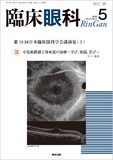Japanese
English
- 有料閲覧
- Abstract 文献概要
- 1ページ目 Look Inside
- 参考文献 Reference
要約 目的:徳島大学病院眼科では,ロービジョン外来の一環として視力や視野などに明らかな異常がないにもかかわらず見え方に問題を抱えている患者を対象とした「視覚認知外来」を開設している。当外来にて書字に問題を抱える女児に対し視覚認知の評価を行い,他科と連携して学校に合理的配慮を申請した1例を報告する。
症例:14歳,女児。起立性調節障害,不登校傾向にて当院小児科を受診したところ,書字の問題を指摘され,視覚認知評価のため当外来に紹介となった。同時期に当院精神科にて神経発達症の精査・診断が行われた。
所見:眼科一般検査では,矯正視力は良好であり,眼位,両眼視機能,前眼部,中間透光体,眼底に異常を認めなかった。感覚過敏によると思われる羞明に対し遮光眼鏡を処方した。フロスティッグ視知覚発達検査(DTVP-A:2)を実施した結果,筆記を伴わない非運動性視知覚は平均以上,筆記を伴う視覚運動統合は平均以下という結果となり,筆記の有無で視覚認知能力に顕著な乖離を認めた。進学予定の高校への合理的配慮申請のため,検査結果の提示および有用な対策の提案を行い環境調整を得た。
結論:本症例では,視覚認知の問題を評価することで患児が抱える問題を明確にし,その結果をもとに合理的配慮の申請を行うことで,学習環境の調整につなげることが可能であった。視覚認知の問題は見え方に関するため,他科のみでの評価は困難であり,視覚認知外来との連携対応が有用であった。
Abstract Purpose:A “Visual Perception Clinic,” aimed at patients experiencing visual perception difficulties despite no apparent abnormalities in visual acuity or other basic ophthalmological findings, has been established by the Department of Ophthalmology at Tokushima University Hospital as part of its low vision care services. This report presents a case wherein a comprehensive evaluation of visual perception was conducted for a child with difficulty writing. Requests for reasonable accommodations were made to their school in collaboration with other medical departments.
Case:A 14-year-old girl was referred to the Visual Perception Clinic for evaluation. She had initially visited the pediatric department for orthostatic dysregulation and school absenteeism. She had been diagnosed with a neurodevelopmental disorder by the psychiatry department previously.
Findings:General ophthalmological examination revealed normal corrected visual acuity, with no abnormalities in ocular alignment, binocular vision function, anterior segment, media clarity, or fundus. Photochromic glasses were prescribed for photophobia, which was likely caused by sensory hypersensitivity. The Developmental Test of Visual Perception-Adolescent and Adult(DTVP-A:2)indicated above-average non-motor visual perception abilities;however, the visual-motor integration abilities requiring handwriting were below-average. The visual perception capabilities with and without handwriting tasks exhibited significant discrepancies. The test results were presented to the prospective high school, and useful strategies were proposed. Environmental adjustments were made through a reasonable accommodation request.
Conclusion:Evaluating the visual perception issues of the patient elucidated her challenges and enabled the submission of a reasonable accommodation request to optimize the learning environment. Visual perception problems are directly related to how patients perceive their surroundings. Thus, ophthalmic evaluations complement assessments by other departments. Collaboration with the Visual Perception Clinic effectively addressed the needs of the patient.

Copyright © 2025, Igaku-Shoin Ltd. All rights reserved.


